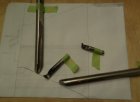- Joined
- Nov 1, 2013
- Messages
- 325
- Likes
- 739
- Location
- Gulfport, MS
- Website
- www.woodtreasuresbybreck.com
I have used just about every tool made for wood turners at least once it seems,(that I know of) except for an end grain ring tool cutter. I'm curious. To those of you who have experience with them please enlighten me to their advantages. I know enough about them that they are primarily for end grain hollowing/turning but are they effective enough to warrant getting one? I haven't found anything I can't turn with a gouge yet, but if they have an advantage I want to know.
Another question can they be used for the under cutting of a bowl rim, like a hunter carbide cutter is? Being from that i'm sure rare group of wood turners I call a tool junkies I'm wondering if I should add one to my collection?
Another question can they be used for the under cutting of a bowl rim, like a hunter carbide cutter is? Being from that i'm sure rare group of wood turners I call a tool junkies I'm wondering if I should add one to my collection?

